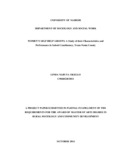| dc.description.abstract | Recently
issues of
women Self
-
help groups have gained
grounds.
Kenya like
many other
Sub
-
Saharan
Africa
n
countries has
a vibr
ant history of self
-
help
groups.
Self
-
help
groups
play a major role in poverty alleviation in rural
Kenya.
Self
-
help groups are informal
groups of people who come together usually for the purpose of saving and borrowing
from one another
in a rotational ma
nner,
and also sharing knowledge and ideas and
helping each other in times of
needs. The
various self
-
help groups differ in nature
,
membership, activities
they engage in and the group operations and other dynamics.
This was
a case study and the main objec
tive was to assess the group characteristics and
performance of self
-
help groups in Saboti Constituency
, Trans
-
N
zoia
County. The
specific objectives were to find out the profiles of the selected self
-
help
groups,
to
examine
the characteristics of individua
l women
participants, to
assess the level of rural
women
participation, to
find out the income generating activities
undertaken, to
examine
member benefits and lastly to find out the level of external assistance received by the
self
-
help
groups.
The study
was quantitative and relied on primary and secondary data to source for
information. Data was gathered through semi
-
structured interview schedules and
observation guide from self
-
help group officials and members of the self
-
help groups.
Sampling was done
using both probability and non
-
probability sampling.
The
researcher found out that there was a lot
of information about the diverse nature of
self
-
help groups with a majority being formed along economic lines while a few being
socially
inclined.
It
was al
so clear that
a
majority
of the self
-
help groups were formed by
individuals through self
-
effort while a few as a result of NGO
motivation. The
groups
consisted of mostly 15
-
20 members
who meet periodically at fixed intervals to
discuss,
reflect
on and find
solutions to their socio
-
econo
mic
issues. The
groups had
rules
governing the
ir
operations
on participation
, use
of savings and
penalties
for effective
administration and management of groups
The
researcher
also
found
out that self
-
help
groups
empowered
w
omen by undertaking
income generating activities which
mad
e them economically independent and decision
makers. The
results revealed that self
-
help groups empower
ed
members by awakening
self
-
assertiveness and confidence among
them, increase
d
their income
le
vel,
and
help
ed
them acquire skills and participate in decision making at home and in their
communities.
The
self
-
help groups had
a variety
of strategies that are geared towards the improvement
of living sta
ndards of members which included
access to
cred
it, skill
training and income
generating
activities.
One
recommendation was that
that in order to enhance performance
of the self
-
help groups there was
need to improve the nature of the self
-
help
groups,
enhance
strategies of
participation, improve
marketi
ng fac
ilities and also training should
be intensified with basic orientation as well as skill development | en_US |

